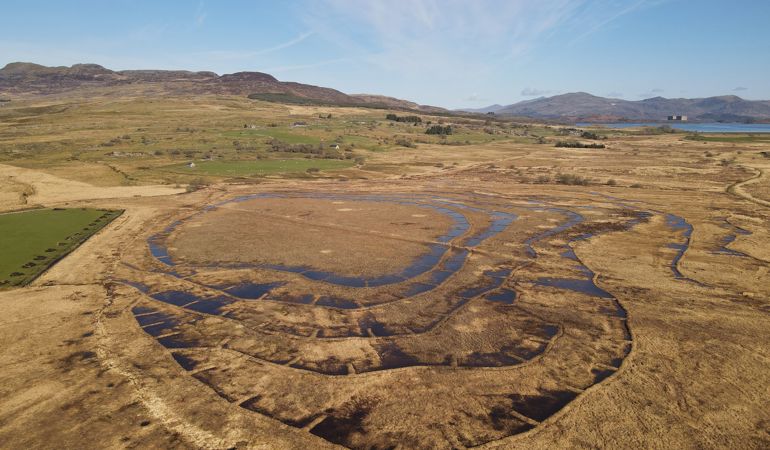First ever peatland restoration at Trawsfynydd captured by drone

New drone images show peatland restoration work is improving natural water levels.
The Natural Resources Wales’s (NRW) LIFE Welsh Raised Bogs Project has installed low level contour bunding for the first time on Cors Goch Trawsfynydd.
This is the first time that any peatland restoration ground works have taken place on this important site to restore water levels, which sits within the Eryri National Park (Snowdonia).
The new drone images shows that restoration methods are having an immediate and remarkable difference on natural water levels at the site.
The project has worked with contractors in February and March and have now completed restoration work. Work will commence again in the autumn and winter.
The project has installed over 5,400 metres of low-level contour peat bunds and cut 25 hectares of dominant and dense Molinia grass.
These work methods will all improve the natural water levels of the bog and ensure it remains wet and spongy - ideal conditions for important plants like sphagnum, and for wildlife.
NRW is working hard to protect large carbon stores on the sites that is manages. By restoring habitats and damaged peatlands, it hopes to increase the carbon captured and reduce emissions from its land for the benefit of future generations.
Jake White from the LIFE Welsh Raised Bogs project said: “We are delighted with the work so far and it so good to see such an immediate impact with the bunds holding so much water only a few days after work has been completed.
“We are very grateful to the landowners and farmers for allowing us to carry out this work, and grateful to the contractors Dinsdale Moorland Specialists for their support.”
The site has suffered due to due historic peat cutting and drainage in the past.
Before works took place this year, water levels in the raised bog were dropping as low as 35cm below the surface of the peatland during the summer – resulting in the important habitat drying out and releasing CO2 into the atmosphere.
Rhys Owen, the National Park Authority’s Head of Conservation, Woodlands and Agriculture said: “It’s fantastic to see all the peatland restoration work being undertaken by various agencies in Eryri, and especially the different techniques being used. We look forward to seeing the impact that these restoration works will have on the Cors Goch site.”
The water table in a healthy raised bogs should be between 5-10cm to the surface for the majority of the year, this data shows that work to restore natural water levels on peatland is vital to ensure the long-term resilience of this rare habitat.
Bunds are low level banks of peat and help to plug holes and cracks appearing on some parts of the bog that have become drier. The bunds act like dams and stop water from flowing off the bog.
Cors Goch Trawsfynydd contains around eight metres of peat and can be found next door to Trawsfynydd Power Station lake, which is owned by Magnox.
To find out more about peatland restoration projects in Wales, please visit the National Peatland Action Programme website.
